Study of the Scattering Effect by SiO2 Nanoparticles, in a Luminescent Solar Concentrator Sensitized with Carbon Dots
Abstract
:1. Introduction
2. Materials and Methods
2.1. Materials
2.1.1. Synthesis of C-QDs
2.1.2. Synthesis of SiO2 Nps
2.1.3. Fabrication of Luminescent Solar Concentrator
2.2. Characterization Techniques
3. Results and Discussion
4. Conclusions
Author Contributions
Funding
Data Availability Statement
Acknowledgments
Conflicts of Interest
References
- Griffini, G. Host Matrix Materials for Luminescent Solar Concentrators: Recent Achievements and Forthcoming Challenges. Front. Mater. 2019, 6, 29. [Google Scholar] [CrossRef]
- Papakonstantinou, I.; Portnoi, M.; Debije, M.G. The Hidden Potential of Luminescent Solar Concentrators. Adv. Energy Mater. 2021, 11, 2002883. [Google Scholar] [CrossRef]
- Xu, B.; Wang, J.; Cai, C.; Xin, W.; Wei, L.; Yang, Q.; Peng, B.; Hu, Y.; Li, J.; Wang, X. Construction of Laminated Luminescent Solar Concentrator ‘Smart’ Window Based on Thermoresponsive Polymer and Carbon Quantum Dots. Crystals 2022, 12, 1612. [Google Scholar] [CrossRef]
- Meinardi, F.; Bruni, F.; Brovelli, S. Luminescent Solar Concentrators for Building-Integrated Photovoltaics. Nat. Rev. Mater. 2017, 2, 1–9. [Google Scholar] [CrossRef]
- Wang, W.; Johnny, C.H. Luminescent Concentrators Enable Highly Efficient and Broadband Photodetection. Light Sci. Appl. 2022, 11, 10–12. [Google Scholar] [CrossRef]
- Moraitis, P.; Schropp, R.E.I.; Van Sark, W.G.J.H.M. Nanoparticles for Luminescent Solar Concentrators—A Review. Opt. Mater. 2018, 84, 636–645. [Google Scholar] [CrossRef]
- Stepanidenko, E.A.; Ushakova, E.V.; Fedorov, A.V.; Rogach, A.L. Applications of Carbon Dots in Optoelectronics. Nanomaterials 2021, 11, 364. [Google Scholar] [CrossRef]
- Fan, Q.; Dehankar, A.; Porter, T.K.; Winter, J.O. Effect of Micelle Encapsulation on Toxicity of CdSe/ZnS and Mn-Doped ZnSe Quantum Dots. Coatings 2021, 11, 895. [Google Scholar] [CrossRef]
- Zhu, C.; Chen, Z.; Gao, S.; Goh, B.L.; Samsudin, I.B.; Lwe, K.W.; Wu, Y.; Wu, C.; Su, X. Recent Advances in Non-Toxic Quantum Dots and Their Biomedical Applications. Prog. Nat. Sci. Mater. Int. 2019, 29, 628–640. [Google Scholar] [CrossRef]
- Nikazar, S.; Sivasankarapillai, V.S.; Rahdar, A.; Gasmi, S.; Anumol, P.S.; Shanavas, M.S. Revisiting the Cytotoxicity of Quantum Dots: An in-Depth Overview. Biophys. Rev. 2020, 12, 703–718. [Google Scholar] [CrossRef]
- Liu, J.; Li, R.; Yang, B. Carbon Dots: A New Type of Carbon-Based Nanomaterial with Wide Applications. ACS Cent. Sci. 2020, 6, 2179–2195. [Google Scholar] [CrossRef]
- Tuccitto, N.; Fichera, L.; Ruffino, R.; Cantaro, V.; Sfuncia, G.; Nicotra, G.; Sfrazzetto, G.T.; Li-Destri, G.; Valenti, A.; Licciardello, A.; et al. Carbon Quantum Dots as Fluorescence Nanochemosensors for Selective Detection of Amino Acids. ACS Appl. Nano Mater. 2021, 4, 6250–6256. [Google Scholar] [CrossRef]
- Yan, F.; Sun, Z.; Zhang, H.; Sun, X.; Jiang, Y.; Bai, Z. The Fluorescence Mechanism of Carbon Dots, and Methods for Tuning Their Emission Color: A Review. Microchim. Acta 2019, 186, 11–37. [Google Scholar] [CrossRef] [PubMed]
- Lim, S.Y.; Shen, W.; Gao, Z. Carbon quantum dots and their applications. Chem. Soc. Rev. 2015, 44, 362–381. [Google Scholar] [CrossRef]
- Sachdev, A.; Matai, I.; Gopinath, P. Implications of surface passivation on physicochemical and bioimaging properties of carbon dots. RSC Adv. 2014, 4, 20915–20921. [Google Scholar] [CrossRef]
- Li, L.; Dong, T. Photoluminescence Tuning in Carbon Dots: Surface Passivation or/and Functionalization, Heteroatom Doping. J. Mater. Chem. C 2018, 6, 7944–7970. [Google Scholar] [CrossRef]
- Liu, Y.; Wang, P.; Fernando, K.S.; LeCroy, G.E.; Maimaiti, H.; Harruff-Miller, B.A.; Lewis, W.K.; Bunker, C.E.; Hou, Z.; Sun, Y. Enhanced fluorescence properties of carbon dots in polymer films. J. Mater. Chem. C 2016, 4, 6967–6974. [Google Scholar] [CrossRef]
- Jiang, Z.C.; Lin, T.N.; Lin, H.T.; Talite, M.J.; Tzeng, T.T.; Hsu, C.L.; Chiu, K.P.; Lin, C.A.J.; Shen, J.L.; Yuan, C.T. A Facile and Low-Cost Method to Enhance the Internal Quantum Yield and External Light-Extraction Efficiency for Flexible Light-Emitting Carbon-Dot Films. Sci. Rep. 2016, 6, 19991. [Google Scholar] [CrossRef] [PubMed]
- Wang, Z.; Zhao, X.; Guo, Z.; Miao, P.; Gong, X. Carbon dots based nanocomposite thin film for highly efficient luminescent solar concentrators. Org. Electron. 2018, 62, 284–289. [Google Scholar] [CrossRef]
- Zhou, Y.; Benetti, D.; Tong, X.; Jin, L.; Wang, Z.M.; Ma, D.; Zhao, H.; Rosei, F. Colloidal carbon dots based highly stable luminescent solar concentrators. Nano Energy 2018, 44, 378–387. [Google Scholar] [CrossRef]
- Zhao, H.; Liu, G.; Han, G. High-performance laminated luminescent solar concentrators based on colloidal carbon quantum dots. Nanoscale Adv. 2019, 1, 4888–4894. [Google Scholar] [CrossRef]
- Zhao, H.; Liu, B.; Wang, L.; Gong, X.; Zhang, Y. Metal Ions-Capped Carbon Quantum Dots for Efficient Luminescent Solar Concentrators. SSRN 2022. [Google Scholar] [CrossRef]
- Zhao, H.; Benetti, D.; Tong, X.; Zhang, H.; Zhou, Y.; Liu, G.; Ma, D.; Sun, S.; Wang, Z.M.; Wang, Y.; et al. Efficient and stable tandem luminescent solar concentrators based on carbon dots and perovskite quantum dots. Nano Energy 2018, 50, 756–765. [Google Scholar] [CrossRef]
- Liu, X.; Benetti, D.; Rosei, F. Semi-transparent luminescent solar concentrators based on plasmon-enhanced carbon dots. J. Mater. Chem. A 2021, 9, 23345–23352. [Google Scholar] [CrossRef]
- Tummeltshammer, C.; Taylor, A.; Kenyon, A.J.; Papakonstantinou, I. Losses in luminescent solar concentrators unveiled. Sol. Energy Mater. Sol. Cells 2016, 144, 40–47. [Google Scholar] [CrossRef]
- Koo, H.J.; Park, J.; Yoo, B.; Yoo, K.; Kim, K.; Park, N.G. Size-dependent scattering efficiency in dye-sensitized solar cell. Inorg. Chim. Acta 2008, 361, 677–683. [Google Scholar] [CrossRef]
- Li, Z.T.; Li, J.X.; Li, J.S.; Deng, Z.H.; Deng, Y.H.; Tang, Y. Scattering effect on optical performance of quantum dot white light-emitting diodes incorporating SiO₂ nanoparticles. IEEE J. Quantum Electron. 2020, 56, 1–9. [Google Scholar] [CrossRef]
- Rafiaei, S.M.; Karimzadeh, E.; Khodaei, M.; Ashrafi, F. Improved optical properties of Dy3+ doped phosphors by spherical SiO2 particles. Ceram. Int. 2019, 45, 21725–21734. [Google Scholar] [CrossRef]
- Chau, J.L.H.; Chen, R.T.; Hwang, G.L.; Tsai, P.Y.; Lin, C.C. Transparent solar cell window module. Sol. Energy Mater. Sol. Cells 2010, 94, 588–591. [Google Scholar] [CrossRef]
- Debije, M.G.; Teunissen, J.P.; Kastelijn, M.J.; Verbunt, P.P.; Bastiaansen, C.W. The effect of a scattering layer on the edge output of a luminescent solar concentrator. Sol. Energy Mater. Sol. Cells 2009, 93, 1345–1350. [Google Scholar] [CrossRef]
- Zhao, X.; Wang, A.; Gao, S.; Yan, D.; Guo, W.; Xu, Y.; Meng, Y.; Wang, C.; Shan, G. Enhancing photoluminescence of carbon quantum dots doped PVA films with randomly dispersed silica microspheres. Sci. Rep. 2020, 10, 5710. [Google Scholar] [CrossRef]
- Zhang, F.; Bao, J.; Gao, C. Design and optimization of transparent scattering solar concentrator based on SiO2 aerogel. JUSTC 2022, 52, 2. [Google Scholar] [CrossRef]
- Liu, H.; Li, S.; Chen, W.; Wang, D.; Li, C.; Wu, D.; Hao, J.; Zhou, Z.; Wang, X.; Wang, K. Scattering Enhanced Quantum Dots Based Luminescent Solar Concentrators by Silica Microparticles. Sol. Energy Mater. Sol. Cells 2018, 179, 380–385. [Google Scholar] [CrossRef]
- Lu, Q.; Xu, S.; Shao, H.; Huang, G.; Xu, J.; Cui, Y.; Ban, D.; Wang, C. Improving power conversion efficiency in luminescent solar concentrators using nanoparticle fluorescence and scattering. Nanotechnology 2020, 31, 455205. [Google Scholar] [CrossRef]
- Tian, Z.; Zhang, X.; Li, D.; Zhou, D.; Jing, P.; Shen, D.; Qu, S.; Zboril, R.; Rogach, A.L. Full-Color Inorganic Carbon Dot Phosphors for White-Light-Emitting Diodes. Adv. Opt. Mater. 2017, 5, 1700416. [Google Scholar] [CrossRef]
- Song, X.; Guo, Q.; Cai, Z.; Qiu, J.; Dong, G. Synthesis of multi-color fluorescent carbon quantum dots and solid state CQDs@SiO2 nanophosphors for light-emitting devices. Ceram. Int. 2019, 45, 17387–17394. [Google Scholar] [CrossRef]
- Lee, M.J.; Park, J.Y.; Kim, C.S.; Okuyama, K.; Lee, S.E.; Kim, T.O. Improvement of light scattering capacity in dye-sensitized solar cells by doping with SiO2 nanoparticles. J. Power Sources 2016, 327, 96–103. [Google Scholar] [CrossRef]
- Shao, P.; Chen, X.; Guo, X.; Zhang, W.; Chang, F.; Liu, Q.; Chen, Q.; Li, J.; Li, Y.; He, D. Facile embedding of SiO2 nanoparticles in organic solar cells for performance improvement. Org. Electron. 2017, 50, 77–81. [Google Scholar] [CrossRef]
- Sudolska, M.; Dubecky, M.; Sarkar, S.; Reckmeier, C.J.; Zbořil, R.; Rogach, A.L.; Otyepka, M. Nature of Absorption Bands in Oxygen-Functionalized Graphitic Carbon Dots. J. Phys. Chem. C 2015, 119, 13369–13373. [Google Scholar] [CrossRef]
- Liu, M. Optical Properties of Carbon Dots: A Review. Nanoarchitectonics 2020, 1, 1–12. [Google Scholar] [CrossRef]
- Kumar, V.B.; Sahu, A.K.; Mohsin, A.S.M.; Li, X.; Gedanken, A. Refractive-Index Tuning of Highly Fluorescent Carbon Dots. ACS Appl. Mater. Interfaces 2017, 9, 28930–28938. [Google Scholar] [CrossRef] [PubMed]
- Zhao, H. Refractive index dependent optical property of carbon dots integrated luminescent solar concentrators. J. Lumin. 2019, 211, 150–156. [Google Scholar] [CrossRef]
- Soliman, T.S.; Vshivkov, S.A.; Elkalashy, S. Structural, thermal, and linear optical properties of SiO2 nanoparticles dispersed in polyvinyl alcohol nanocomposite films. Polym. Compos. 2020, 41, 3340–3350. [Google Scholar] [CrossRef]
- Grehan, G.; Gouesbet, G. Mie theory calculations: New progress, with emphasis on particle sizing. Appl. Opt. 1979, 18, 3489–3493. [Google Scholar] [CrossRef] [PubMed]
- Chai, J.Y.; Wong, B.T. Study of light scattering by TiO2, Ag, and SiO2 nanofluids with particle diameters of 20–60 nm. J. Nano Res. 2019, 60, 1–20. [Google Scholar] [CrossRef]
- Li, X.; Rui, M.; Song, J.; Shen, Z.; Zeng, H. Carbon and graphene quantum dots for optoelectronic and energy devices: A review. Adv. Funct. Mater. 2015, 25, 4929–4947. [Google Scholar] [CrossRef]
- Wang, X.; Zhang, Y.; Li, J.; Liu, G.; Gao, M.; Ren, S.; Liu, B.; Zhang, L.; Han, G.; Yu, J.; et al. Platinum cluster/carbon quantum dots derived graphene heterostructured carbon nanofibers for efficient and durable solar-driven electrochemical hydrogen evolution. Small Methods 2022, 6, 2101470. [Google Scholar] [CrossRef] [PubMed]
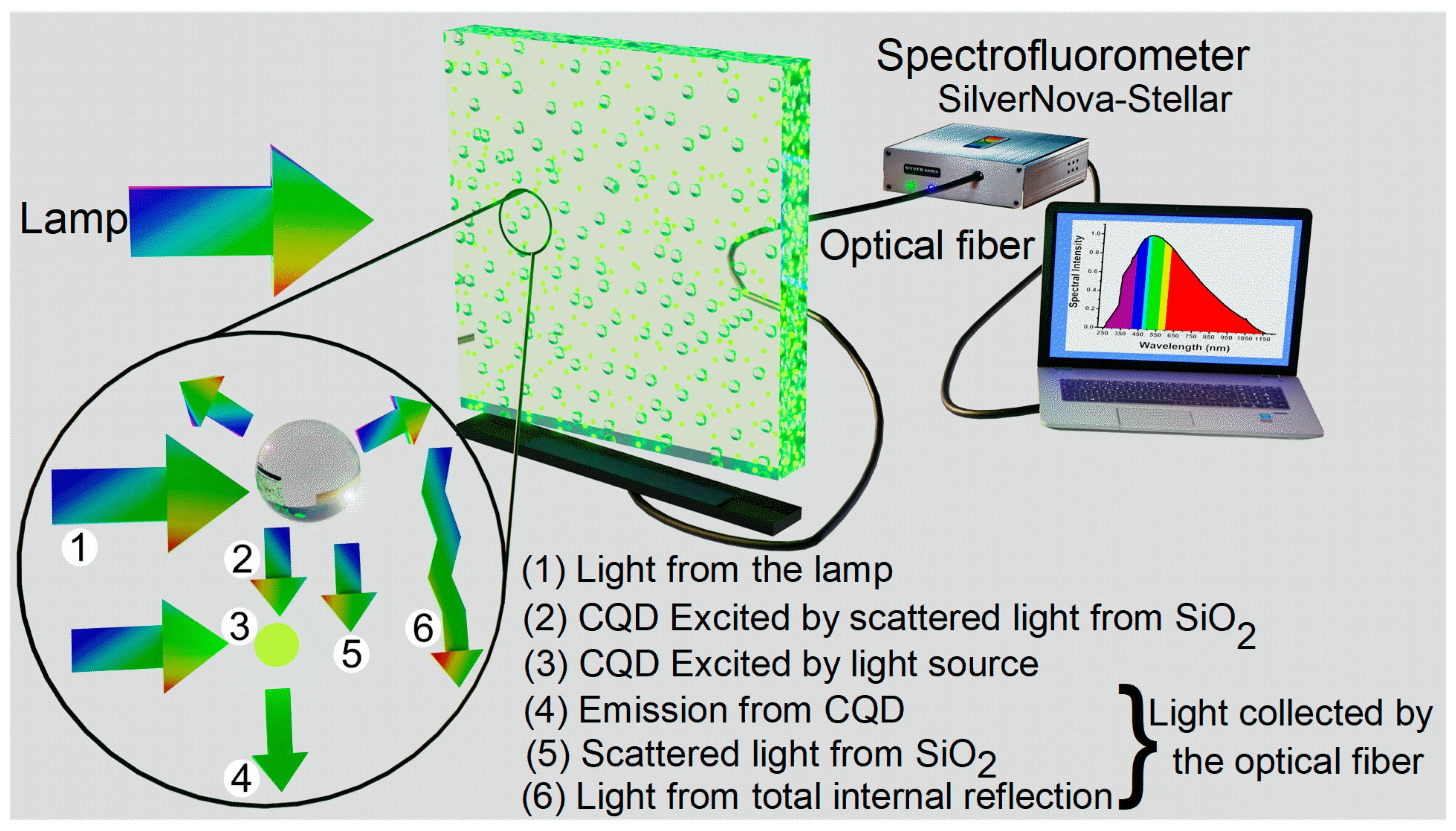
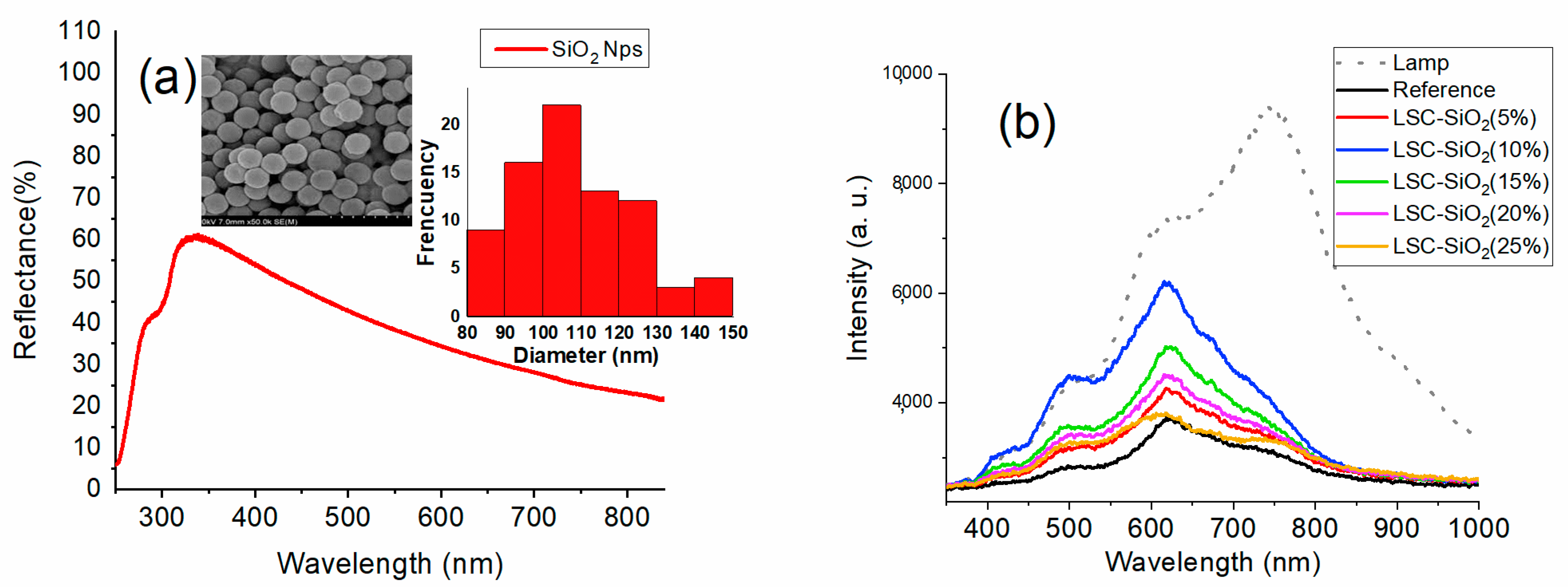

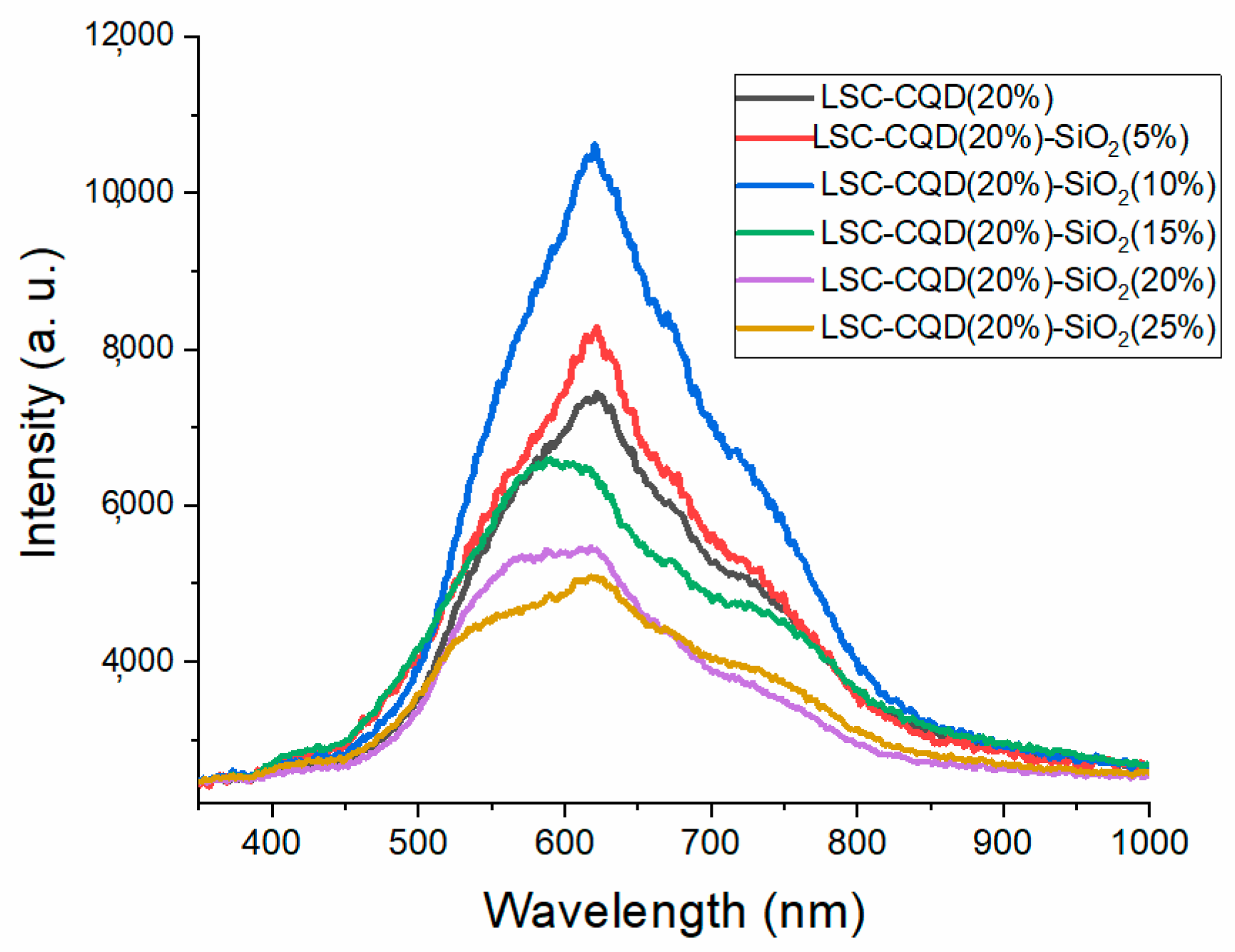
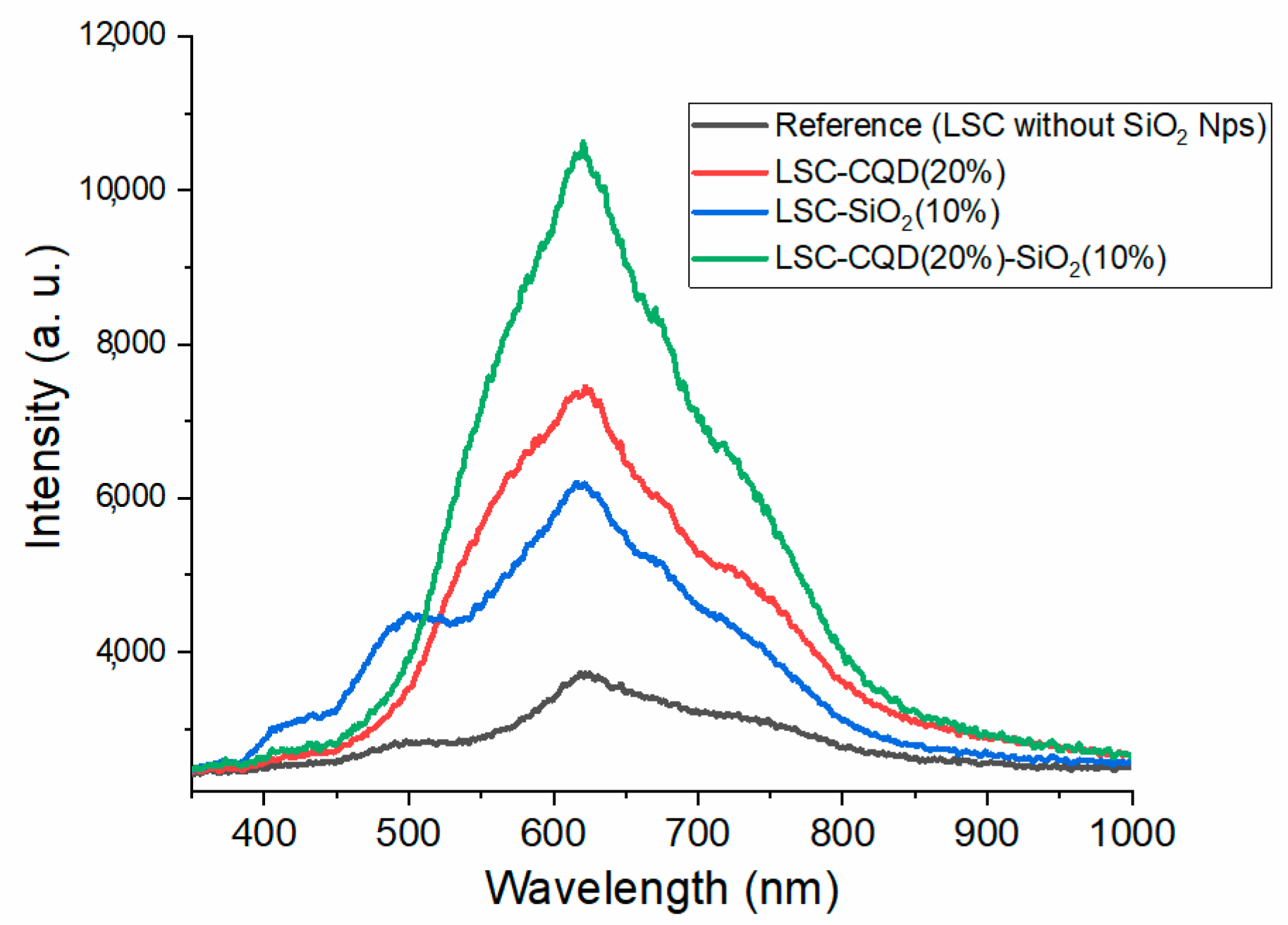
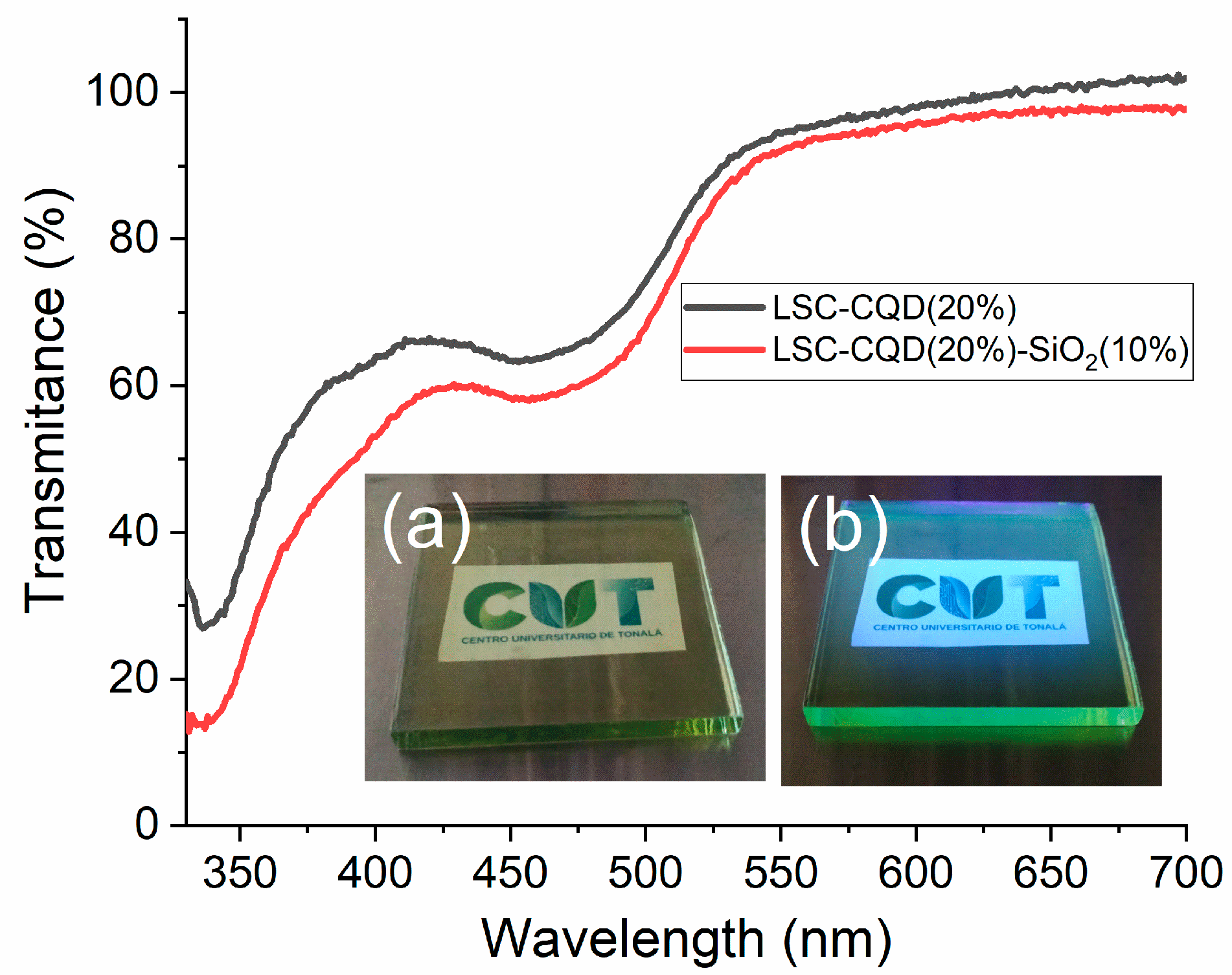
Disclaimer/Publisher’s Note: The statements, opinions and data contained in all publications are solely those of the individual author(s) and contributor(s) and not of MDPI and/or the editor(s). MDPI and/or the editor(s) disclaim responsibility for any injury to people or property resulting from any ideas, methods, instructions or products referred to in the content. |
© 2023 by the authors. Licensee MDPI, Basel, Switzerland. This article is an open access article distributed under the terms and conditions of the Creative Commons Attribution (CC BY) license (https://creativecommons.org/licenses/by/4.0/).
Share and Cite
Polché, M.; José Miguel, B.F.; Guzmán González, C.A.; González Contreras, G.; Romero Arellano, V.H. Study of the Scattering Effect by SiO2 Nanoparticles, in a Luminescent Solar Concentrator Sensitized with Carbon Dots. Nanomaterials 2023, 13, 2480. https://doi.org/10.3390/nano13172480
Polché M, José Miguel BF, Guzmán González CA, González Contreras G, Romero Arellano VH. Study of the Scattering Effect by SiO2 Nanoparticles, in a Luminescent Solar Concentrator Sensitized with Carbon Dots. Nanomaterials. 2023; 13(17):2480. https://doi.org/10.3390/nano13172480
Chicago/Turabian StylePolché, Mackenson, Blancas Flores José Miguel, Carlos Alberto Guzmán González, Gabriel González Contreras, and Victor Hugo Romero Arellano. 2023. "Study of the Scattering Effect by SiO2 Nanoparticles, in a Luminescent Solar Concentrator Sensitized with Carbon Dots" Nanomaterials 13, no. 17: 2480. https://doi.org/10.3390/nano13172480
APA StylePolché, M., José Miguel, B. F., Guzmán González, C. A., González Contreras, G., & Romero Arellano, V. H. (2023). Study of the Scattering Effect by SiO2 Nanoparticles, in a Luminescent Solar Concentrator Sensitized with Carbon Dots. Nanomaterials, 13(17), 2480. https://doi.org/10.3390/nano13172480







